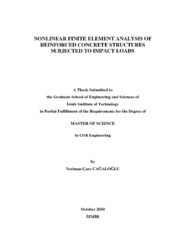Please use this identifier to cite or link to this item:
https://hdl.handle.net/11147/3065Full metadata record
| DC Field | Value | Language |
|---|---|---|
| dc.contributor.advisor | Saatcı, Selçuk | - |
| dc.contributor.author | Cağaloğlu, Neriman Çare | - |
| dc.date.accessioned | 2014-07-22T13:50:49Z | - |
| dc.date.available | 2014-07-22T13:50:49Z | - |
| dc.date.issued | 2010 | - |
| dc.identifier.uri | http://hdl.handle.net/11147/3065 | - |
| dc.description | Thesis (Master)--Izmir Institute of Technology, Civil Engineering, Izmir, 2010 | en_US |
| dc.description | Includes bibliographical references (leaves: 84-85) | en_US |
| dc.description | Text in English; Abstract: Turkish and English | en_US |
| dc.description | xv, 90 leaves | en_US |
| dc.description.abstract | Design of reinforced concrete structures against extreme loads, such as impact and blast loads, is increasingly gaining importance. However, due to the problem.s complicated nature, there exists no commonly accepted methodology or a design code for the analysis and design of such structures under impact loads. Therefore, engineers and researchers commonly resort to the numerical methods, such as the finite element method, and utilize different methods and techniques for the analysis and design. Although each method has its advantages and disadvantages, usually engineers and researchers persist on their method of choice, without evaluating the performance of other methods available. In addition, there is no significant study in the literature comparing the methods available that can guide the engineers and researchers working in the area. This study compares the performance of some numerical methods for the impact analysis and design with the help from actual impact test results in the literature. Computer programs VecTor2 and VecTor3 were selected for nonlinear finite element methodology, which were based on the Modified Compression Field Theory. Impact tests conducted on reinforced concrete beams were modeled and analyzed using these programs. Moreover, same beams were modeled also using a single degree of freedom spring system method. The results obtained from both approaches were compared with each other and the test results, considering their accuracy, computation time, and ease of use. | en_US |
| dc.language.iso | en | en_US |
| dc.publisher | Izmir Institute of Technology | en_US |
| dc.rights | info:eu-repo/semantics/openAccess | en_US |
| dc.subject.lcsh | Structural analysis (Engineering) | en |
| dc.subject.lcsh | Impact | en |
| dc.subject.lcsh | Reinforced concrete construction | en |
| dc.subject.lcsh | Finite element method | en |
| dc.title | Nonlinear Finite Element Analysis of Reinforced Concrete Structures Subjected To Impact Loads | en_US |
| dc.type | Master Thesis | en_US |
| dc.institutionauthor | Cağaloğlu, Neriman Çare | - |
| dc.department | Thesis (Master)--İzmir Institute of Technology, Civil Engineering | en_US |
| dc.relation.publicationcategory | Tez | en_US |
| dc.identifier.wosquality | N/A | - |
| dc.identifier.scopusquality | N/A | - |
| item.openairecristype | http://purl.org/coar/resource_type/c_18cf | - |
| item.languageiso639-1 | en | - |
| item.openairetype | Master Thesis | - |
| item.grantfulltext | open | - |
| item.fulltext | With Fulltext | - |
| item.cerifentitytype | Publications | - |
| Appears in Collections: | Master Degree / Yüksek Lisans Tezleri | |
Files in This Item:
| File | Description | Size | Format | |
|---|---|---|---|---|
| T000882.pdf | MasterThesis | 4.98 MB | Adobe PDF |  View/Open |
CORE Recommender
Page view(s)
340
checked on Mar 31, 2025
Download(s)
188
checked on Mar 31, 2025
Google ScholarTM
Check
Items in GCRIS Repository are protected by copyright, with all rights reserved, unless otherwise indicated.